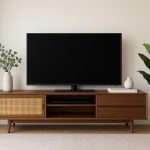With economic shifts, political turbulence, and just the general overwhelm of everyday life, the instability of the outside world has people turning inward. Meaning that homes have become more than just investment assets and aesthetic projects; now they’re survival tools, self-care spaces, and emotional anchors.
Interior design has seen a shift in purpose, which isn’t a bad thing. The home is no longer about creating the picture-perfect Instagram grid; it’s now about designing a space that soothes, adapts, and reassures you. While there’s still a constant clutter of fleeting trends, some of them have been created as a direct response to this collective craving for stability in this uncertain world that we live in.
Why It’s Trending
These aesthetics aren’t about keeping up with yet another trend. There is a response to this shift in how people relate to their homes. It isn’t just post-pandemic burnout and the cost-of-living pressures, digital overload and the climate crisis also play a crucial part in creating this need for emotional durability for spaces that hold people through their lowest points.
Even social media has started to play its part as comfort-focused trends constantly pop up out of nowhere. These aspirational posts and reels are emotional reactions to instability as they offer people a blueprint for building a grounding environment.
Adapting to the Unknown
Alongside the moodier trends, adaptability has become a very practical consideration. Transforming aesthetics from stylish ways to live into functional ones. Homes are now being designed with flexibility in mind to help with the uncertainty of the time.
Modular furniture, for example, adapts with life phases. Going from nesting coffee tables to expandable dining sets if you have guests over or your family grows. Multifunctional spaces became crucial during the pandemic and have remained relevant as they pivot between offices, lounges, and workout zones. For renters, sharers and small-space dwellers, pieces that fold, stack and can be easily stowed away are a life changer. Even durable flooring, like luxury vinyl tiles or engineered wood, that withstands the chaos of life, kids, pets, and whatever else the world throws your way, is a practical shift to flexibility.
Resilience is key, especially when you’re choosing materials. Don’t focus on just the looks, consider how well they hold up and for how long.
How to Design a Home That Makes You Feel Safe
Designing for uncertainty isn’t about panic-prepping or creating a bunker; it’s about layering in warmth, softness, and flexibility. There’s no need to rush in; you can take your time, following the slow decorating movement if you fancy it.
Make Comfort a Priority: Think tactile. You can easily add texture through cushions, throws and rugs by layering them correctly. Think about how heavy curtains and a thick duvet can instantly make a space feel cocooned and cosy. Lighting is also important here! Swap out any harsh overheads for table lamps, floor lights, or fairy lights for a gentle glow.
Create a Home of Memories: Surround yourself with items that hold sentimental value. Think about framed photos, handwritten notes, and random trinkets that mean something to you. Even books with worn spines tell a story beyond the words inside. These little touches offer emotional grounding to your space, especially when the world feels a bit unsteady.
Embrace Flexibility: Life can be unpredictable, and if your furniture can keep up with changes, then that’s one less thing to worry about. Think about multifunctional pieces like a storage ottoman or an extendable dining table; anything that can be reconfigured as your needs shift.
Choose Practical Materials: The appearance of your home is important, but so is its longevity. Think about how stable and durable herringbone wood flooring is, as well as how beautiful it looks. It’s the same with your walls, clay-based paints or limewash finishes aren’t just beautiful, they’re breathable and less prone to flaking.
Design for Versatility: Nowadays, homes are being asked to do more, so it’s important to design with zones in mind. You can use a rug to define a calm reading corner or use bookshelves to create visual barriers. You can even use a folding screen to carve out a workspace. Don’t worry about making everything match; all that matters is that each space feels intentional and comfortable.
Is Resilient Design Worth It?
Absolutely. Designing for uncertain times makes homes more practical and more human. These trends put feelings at the centre of design, which might just make them the most meaningful shift in interior design.
This isn’t about giving up on style either. It’s about understanding that real style isn’t cold, curated perfection. Instead, it’s resilient, comfortable, and even a little bit messy, but in the most beautiful way.
Author Bio:
Sophie Marlowe is a digital content writer and outreach executive for Luxury Flooring. She specialises in crafting engaging blogs on home improvement and home decor with a focus on flooring. Sophie writes handy how-tos, easy guides, and helpful comparisons, letting the reader be informed and inspired to take their home to the next level.
Lynn Martelli is an editor at Readability. She received her MFA in Creative Writing from Antioch University and has worked as an editor for over 10 years. Lynn has edited a wide variety of books, including fiction, non-fiction, memoirs, and more. In her free time, Lynn enjoys reading, writing, and spending time with her family and friends.















